Voyager spacecraft still reaching for the stars and setting records after 40 years
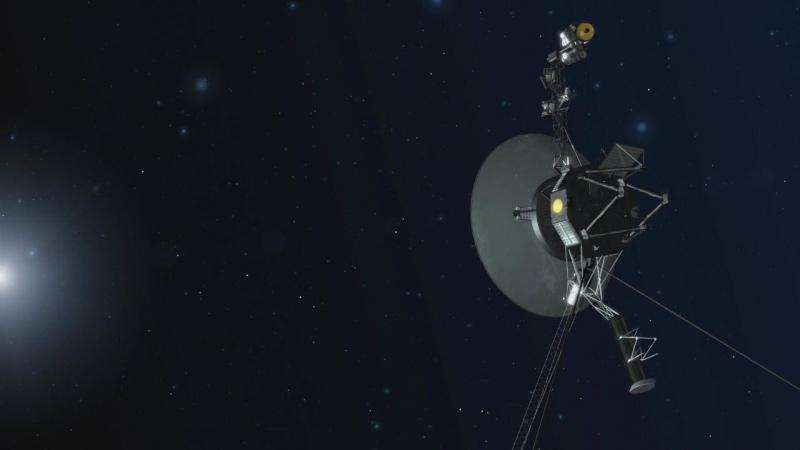
Humanity's farthest and longest-lived spacecraft, Voyager 1 and 2, achieve 40 years of operation and exploration this August and September. Despite their vast distance, they continue to communicate with NASA daily, still probing the final frontier.
Their story has not only impacted generations of current and future scientists and engineers, but also Earth's culture, including film, art and music. Each spacecraft carries a Golden Record of Earth sounds, pictures and messages. Since the spacecraft could last billions of years, these circular time capsules could one day be the only traces of human civilization.
"I believe that few missions can ever match the achievements of the Voyager spacecraft during their four decades of exploration," said Thomas Zurbuchen, associate administrator for NASA's Science Mission Directorate (SMD) at NASA Headquarters. "They have educated us to the unknown wonders of the universe and truly inspired humanity to continue to explore our solar system and beyond."
The Voyagers have set numerous records in their unparalleled journeys. In 2012, Voyager 1, which launched on Sept. 5, 1977, became the only spacecraft to have entered interstellar space. Voyager 2, launched on Aug. 20, 1977, is the only spacecraft to have flown by all four outer planets—Jupiter, Saturn, Uranus and Neptune. Their numerous planetary encounters include discovering the first active volcanoes beyond Earth, on Jupiter's moon Io; hints of a subsurface ocean on Jupiter's moon Europa; the most Earth-like atmosphere in the solar system, on Saturn's moon Titan; the jumbled-up, icy moon Miranda at Uranus; and icy-cold geysers on Neptune's moon Triton.
Though the spacecraft have left the planets far behind—and neither will come remotely close to another star for 40,000 years—the two probes still send back observations about conditions where our Sun's influence diminishes and interstellar space begins.
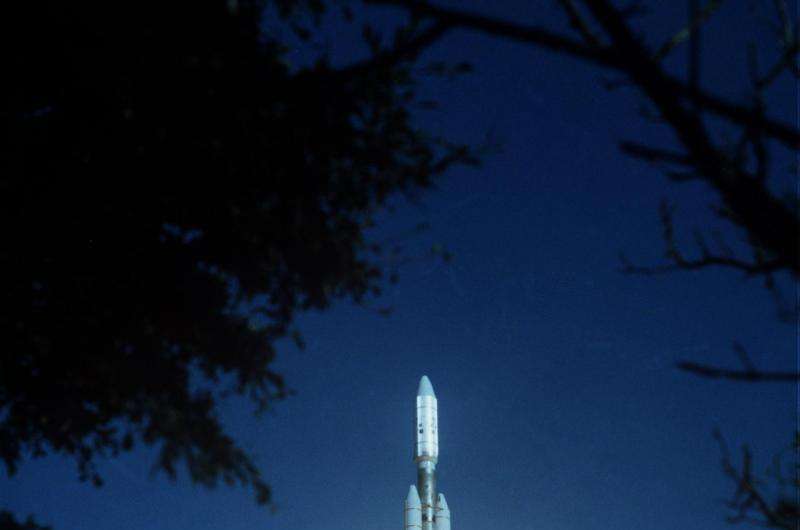
Voyager 1, now almost 13 billion miles from Earth, travels through interstellar space northward out of the plane of the planets. The probe has informed researchers that cosmic rays, atomic nuclei accelerated to nearly the speed of light, are as much as four times more abundant in interstellar space than in the vicinity of Earth. This means the heliosphere, the bubble-like volume containing our solar system's planets and solar wind, effectively acts as a radiation shield for the planets. Voyager 1 also hinted that the magnetic field of the local interstellar medium is wrapped around the heliosphere.
Voyager 2, now almost 11 billion miles from Earth, travels south and is expected to enter interstellar space in the next few years. The different locations of the two Voyagers allow scientists to compare right now two regions of space where the heliosphere interacts with the surrounding interstellar medium using instruments that measure charged particles, magnetic fields, low-frequency radio waves and solar wind plasma. Once Voyager 2 crosses into the interstellar medium, they will also be able to sample the medium from two different locations simultaneously.
"None of us knew, when we launched 40 years ago, that anything would still be working, and continuing on this pioneering journey," said Ed Stone, Voyager project scientist based at Caltech in Pasadena, California. "The most exciting thing they find in the next five years is likely to be something that we didn't know was out there to be discovered."
The twin Voyagers have been cosmic overachievers, thanks to the foresight of mission designers. By preparing for the radiation environment at Jupiter, the harshest of all planets in our solar system, the spacecraft were well equipped for their subsequent journeys. Both Voyagers carry redundant systems that allow the spacecraft to switch to backup systems autonomously when necessary, as well as long-lasting power supplies. Each Voyager has three radioisotope thermoelectric generators, devices that use the heat energy generated from the decay of plutonium-238—only half of it will be gone after 88 years.
Space is almost empty, so the Voyagers are not at a significant level of risk of bombardment by large objects. However, Voyager 1's interstellar space environment is not a complete void. It's filled with clouds of dilute material remaining from stars that exploded as supernovae millions of years ago. This material doesn't pose a danger to the spacecraft, but is a key part of the environment that the Voyager mission is helping scientists study and characterize.
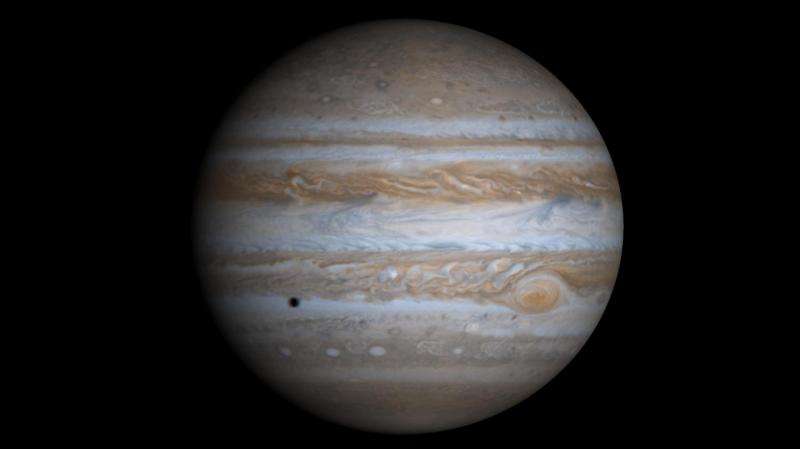
Because the Voyagers' power decreases by four watts per year, engineers are learning how to operate the spacecraft under ever-tighter power constraints. And to maximize the Voyagers' lifespans, they also have to consult documents written decade's earlier describing commands and software, in addition to the expertise of former Voyager engineers.
"The technology is many generations old, and it takes someone with 1970s design experience to understand how the spacecraft operate and what updates can be made to permit them to continue operating today and into the future," said Suzanne Dodd, Voyager project manager based at NASA's Jet Propulsion Laboratory in Pasadena.
Team members estimate they will have to turn off the last science instrument by 2030. However, even after the spacecraft go silent, they'll continue on their trajectories at their present speed of more than 30,000 mph (48,280 kilometers per hour), completing an orbit within the Milky Way every 225 million years.
First and Farthest: How the Voyagers Blazed Trails
Few missions can match the achievements of NASA's groundbreaking Voyager 1 and 2 spacecraft during their 40 years of exploration. Here's a short list of their major accomplishments to date.
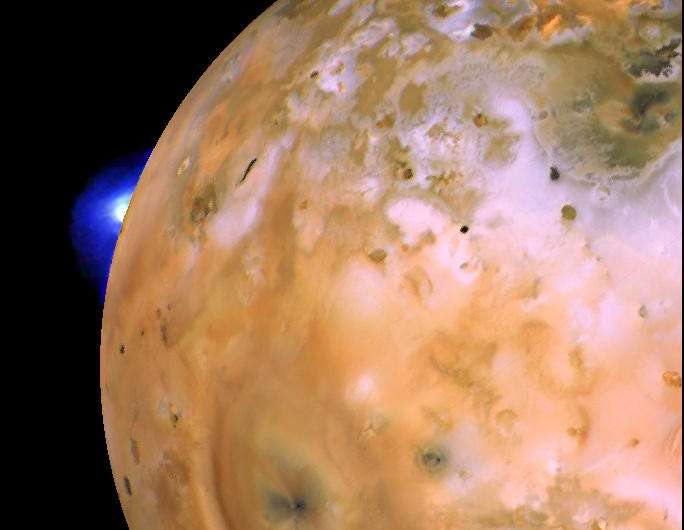
Planetary Firsts
Launched in 1977, the Voyagers delivered many surprises and discoveries from their encounters with the gas giants of the outer solar system: Jupiter, Saturn, Uranus and Neptune. Between 1977 and 1990, the mission attained these distinctions:
- First spacecraft to fly by all four planets of the outer solar system (Voyager 2)
- First mission to discover multiple moons of the four outer planets (both spacecraft): three new moons at Jupiter, four new moons at Saturn, 11 new moons at Uranus, six new moons at Neptune
- First spacecraft to fly by four different target planets (Voyager 2)
- First spacecraft to visit Uranus and Neptune (Voyager 2)
- First spacecraft to image the rings of Jupiter, Uranus and Neptune (Voyager 2)
- First spacecraft to discover active volcanoes beyond Earth (on Jupiter's moon Io—Voyager 1)
- First spacecraft to detect lightning on a planet other than Earth (at Jupiter—Voyager 1)
- First spacecraft to find suggestions of an ocean beyond Earth (at Jupiter's moon Europa—both spacecraft)
- First spacecraft to detect a nitrogen-rich atmosphere found beyond our home planet (at Saturn's moon Titan—Voyager 1)
Heliophysics Firsts
After Voyager 1 departed from Saturn in November 1980, it began a journey to where no human-made object had ever gone before: the space between the stars. On August 25, 2012, it crossed over into interstellar space, leaving behind the heliosphere—the enormous magnetic bubble encompassing our Sun, planets and solar wind. Voyager 2 set course for interstellar space after departing from Neptune in August 1989, and is expected to enter interstellar space in the next few years. Together the Voyagers have taught us a great deal about the extent of our sun's influence and the very nature of the space that lies beyond our planets.
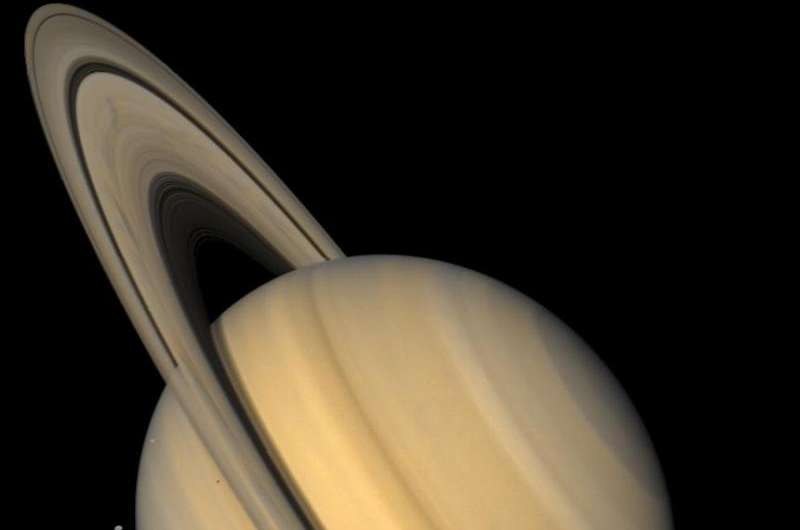
- First spacecraft to leave the heliosphere and enter interstellar space (Voyager 1)
- First spacecraft to measure full intensity of cosmic rays—atoms accelerated to nearly the speed of light—in interstellar space (Voyager 1)
- First spacecraft to measure magnetic field in interstellar space (Voyager 1)
- First spacecraft to measure density of interstellar medium—material ejected by ancient supernovae (Voyager 1)
- First spacecraft to measure solar wind termination shock—the boundary where solar wind charged particles slow below the speed of sound as they begin to press into the interstellar medium (Voyager 2)
Engineering and Computing Firsts and Records
The Voyagers, which launched with nearly identical configurations and instruments, were designed to withstand the harsh radiation environment of Jupiter—the greatest physical challenge they would ever encounter. Preparations for the peril at Jupiter ensured that the Voyagers would be well equipped for the rest of their journeys, too. Engineering and computing advances that the Voyagers debuted set the stage for future missions.
- First spacecraft extensively protected against radiation, which also set the standard for radiation design margin still in use for space missions today
- First spacecraft protected against external electrostatic discharges
- First spacecraft with programmable computer-controlled attitude and articulation (which means the pointing of the spacecraft)
- First spacecraft with autonomous fault protection, able to detect its own problems and take corrective action
- First use of Reed-Solomon code for spacecraft data—an algorithm to reduce errors in data transmission and storage, which is widely used today
- First time engineers linked ground communications antennas together in an array to be able to receive more data (for Voyager 2's Uranus encounter)
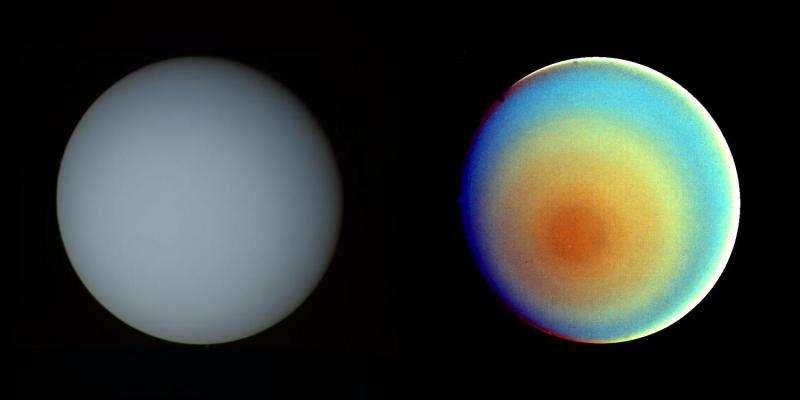
Beyond that, the Voyager spacecraft continue setting endurance and distance records:
- Longest continuously operating spacecraft (Voyager 2, which passed Pioneer 6's record on Aug. 13, 2012)
- Most distant spacecraft from the Sun (Voyager 1, which passed Pioneer 10's distance on Feb. 17, 1998 and is currently about 13 billion miles, or 21 billion kilometers, away)
-
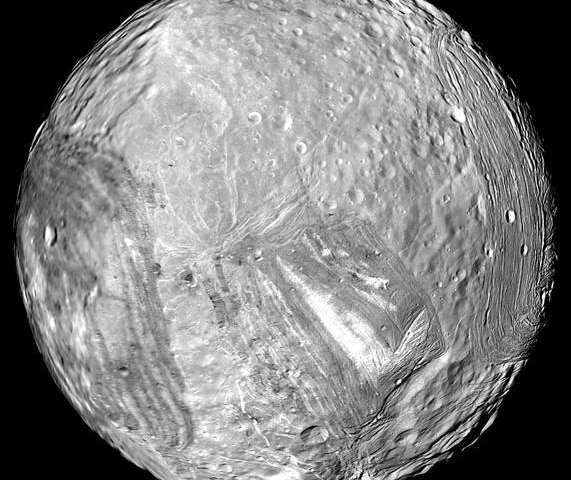
Uranus' icy moon Miranda is seen in this image from Voyager 2 on January 24, 1986. Credit: NASA/JPL-Caltech -
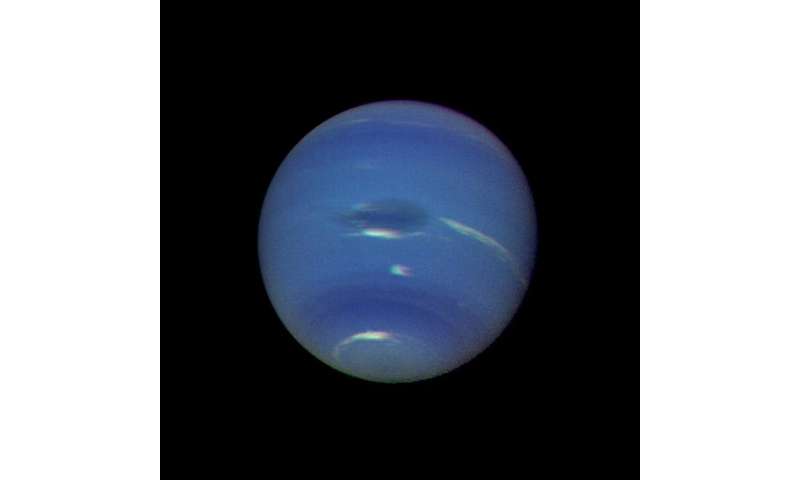
Neptune's blue-green atmosphere is shown in greater detail than ever before by the Voyager 2 spacecraft as it rapidly approaches its encounter with the giant planet. This color image, produced from a distance of about 16 million kilometers, shows several complex and puzzling atmospheric features. The Great Dark Spot (GDS) seen at the center is about 13,000 km by 6,600 km in size -- as large along its longer dimension as the Earth. The bright, wispy "cirrus-type" clouds seen hovering in the vicinity of the GDS are higher in altitude than the dark material of unknown origin which defines its boundaries. A thin veil often fills part of the GDS interior, as seen on the image. The bright cloud at the southern (lower) edge of the GDS measures about 1,000 km in its north-south extent. The small, bright cloud below the GDS, dubbed the "scooter," rotates faster than the GDS, gaining about 30 degrees eastward (toward the right) in longitude every rotation. Bright streaks of cloud at the latitude of the GDS, the small clouds overlying it, and a dimly visible dark protrusion at its western end are examples of dynamic weather patterns on Neptune, which can change significantly on time scales of one rotation (about 18 hours). Credit: NASA/JPL -
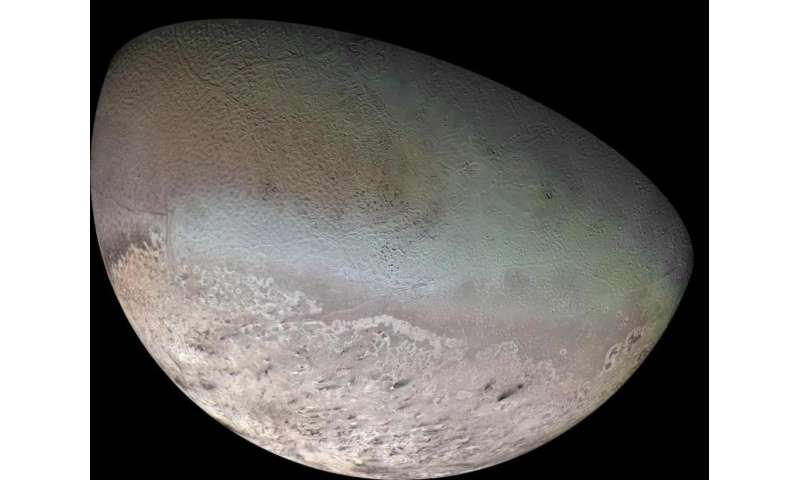
Global color mosaic of Triton, taken in 1989 by Voyager 2 during its flyby of the Neptune system. Color was synthesized by combining high-resolution images taken through orange, violet, and ultraviolet filters; these images were displayed as red, green, and blue images and combined to create this color version. With a radius of 1,350 (839 mi), about 22% smaller than Earth's moon, Triton is by far the largest satellite of Neptune. It is one of only three objects in the Solar System known to have a nitrogen-dominated atmosphere (the others are Earth and Saturn's giant moon, Titan). Triton has the coldest surface known anywhere in the Solar System (38 K, about -391 degrees Fahrenheit); it is so cold that most of Triton's nitrogen is condensed as frost, making it the only satellite in the Solar System known to have a surface made mainly of nitrogen ice. The pinkish deposits constitute a vast south polar cap believed to contain methane ice, which would have reacted under sunlight to form pink or red compounds. The dark streaks overlying these pink ices are believed to be an icy and perhaps carbonaceous dust deposited from huge geyser-like plumes, some of which were found to be active during the Voyager 2 flyby. The bluish-green band visible in this image extends all the way around Triton near the equator; it may consist of relatively fresh nitrogen frost deposits. The greenish areas includes what is called the cantaloupe terrain, whose origin is unknown, and a set of "cryovolcanic" landscapes apparently produced by icy-cold liquids (now frozen) erupted from Triton's interior. Credit: NASA/JPL/USGS
More information: For more information about the Voyager spacecraft, visit: www.nasa.gov/voyager
Provided by Jet Propulsion Laboratory





















